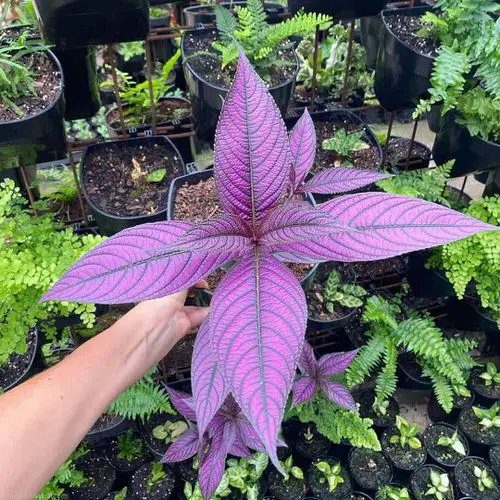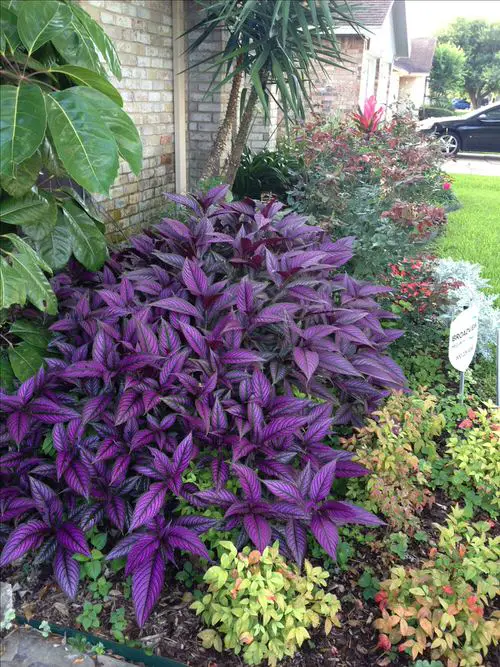Learn How to Grow Persian Shield outdoors in pots or garden beds for beautiful purple foliage or try them indoors.

Ornamental plants with vivid foliage are show stoppers! If you want to include one such specimen in your collection, then here are the details on How to Grow Persian Shield!
Check out some colorful houseplants here
Persian Shield Plant Information
Native to Myanmar (Burma), Persian Shield is popular for its ornamental lance-shaped foliage that has a deep purple-lilac hue with prominent veins. The silvery sheen on the upper surface gives the leaves a metallic touch. The plant grows best as a perennial in zones 8-10.
Botanical Name: Strobilanthes dyerianus
Find out some beautiful houseplants with metallic leaves here
Propagating Persian Shield

The easiest method to propagate a Persian Shield plant is via stem cuttings:
- Cut a 4-5 inches stem just above the leaf node from a healthy Persian Shield plant. Make sure to get the cutting after the blooming season, when new growth emerges.
- Remove all the leaves except the upper pair.
- Now, fill a glass with clean filtered water and dip the cutting in a way that only the stem is submerged in it. Change the water every two days to avoid chances of fungal infestation.
- Place the glass in a location that receives indirect sunlight.
- The cutting will grow roots within a couple of weeks.
- After the roots have grown to about 1 inch, transplant the cutting to a pot containing a well-draining growing medium.
You can also grow its cuttings directly in the soil. For that, dip the end in a rooting hormone and plant the cutting in a well-draining growing medium. The roots will form in 2-4 weeks.
Check out the gorgeous purple houseplants here
Best Spot to Grow Persian Shield

The best spot to grow a Persian shield is anywhere it gets plenty of bright light to enhance its colors. You can also grow it in a large and tall planter with other flowers or trailing plants to make a stunning arrangement.
Requirements For Growing Persian Shield

Sunlight
Persian Shield needs bright indirect light to show off its brilliant vibrant hues. Place the plant at a location that receives 5-6 hours of bright but indirect sunlight.
The plant is a little sensitive when it comes to the harsh afternoon sun exposure as it can fade or burn the foliage.
Soil
It thrives in a rich, well-draining medium with a slightly acidic pH of 5.5-7. Grow the plant in loamy soil amended with plenty of organic manure and ample sand or perlite to maintain a loose consistency.
Watering
Keep the medium thoroughly moist but not drenched. Follow a schedule of watering the soil till it seeps out of the drainage holes at least twice a week. Avoid watering the plant daily. Also, it won’t be wise to let the soil dry out completely as it may harm the plant.
The best procedure to follow is to water the plant when the topsoil feels a little dry to touch.
Temperature
Persian Shield thrives in high temperatures of above 60F or 15C. However, the plant survives in lower temperatures as annuals and features less vibrant colors.
Humidity
Native to the hot and humid climate of Mayanmar, the ornamental shrub loves high humidity of 40-50%. While growing indoors, use a humidifier to fulfill its moisture needs or use a pebble humidity tray.
Learn to make a pebble tray here
Persian Shield Care

Feed the plant with a balanced liquid fertilizer, diluted to half its strength, twice a month in the growing season. Do not fertilize when the temperature goes down or in winters.
Pruning
Apart from snipping away the dead foliage from time to time, pinch the leaves to maintain a bushy appearance of the shrub.
Overwintering
Persian Shields are warm-weather plants, so you’ll need to layer the soil with a thick layer of mulch and provide maximum indirect light to help the plant survive.
Move it indoors under grow light during frost, or you can store the cuttings to propagate new varieties in the next season.
Pest and Diseases
Persian Shield is susceptible to aphids, spider mites, and fungus gnats. Use an insecticidal soap or neem oil solution to drive them away.
A Quick Tip!

The plant also makes for an excellent outdoor specimen where it will look great growing on a side path or corner. Just ensure it is safe from the harsh afternoon sun.


